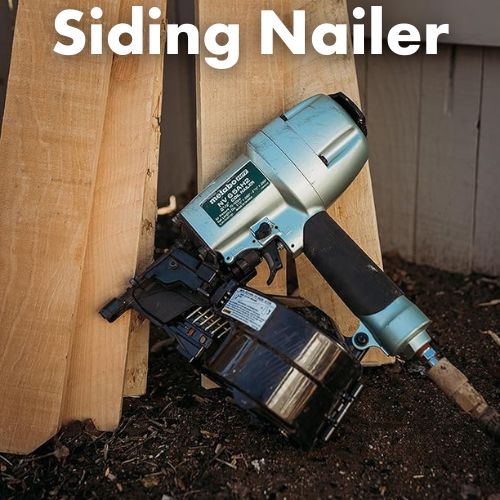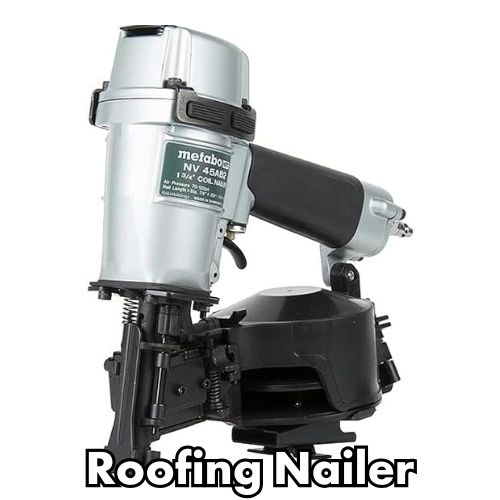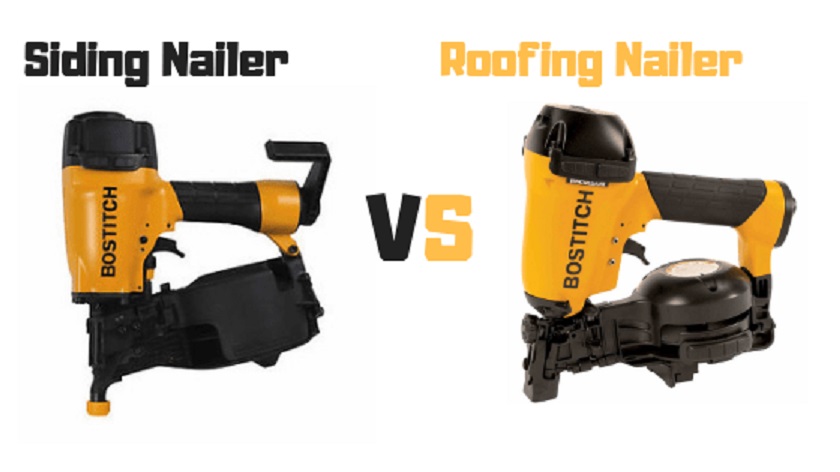Almost all the nailers look similar but there are some subtle differences between them. Each nailer is designed for a specific purpose and works differently.
When it comes to dealing with carpentry and roofing works, there are two types of nailers that one can use i.e., siding nailers and roofing nailers.
Although both of them look quite similar, there are some fundamental differences between them. Each nailer has its advantages and disadvantages.
Therefore, it is essential to know in detail about the differences before deciding which one to use for your specific needs.
Top 2 Best Siding and Roofing Nailers
Best Roofing Nailers
DEWALT DW45RN Roofing Nailer
- Extremely well-built and durable
- Shoot 10 nails per second
- Accurate nailing and reloading is very easy too
- High speed valve technology
- Lighter than other coil roofing nail guns
- Robust engine.
- Depth adjust wheel with numbered detents
Best Siding Nailer
DEWALT DW66C Siding Nailer
- Easy to load, and use
- Working great for cedar and Hardie concrete fiber siding
- The magazine holds up to 300 nails
- Tool-free adjustable exhaust
- Aluminum body
- Smooth rubber foot.
- Weight: 4.9 lbs
What is a Siding Nailer?
Siding nailers are for attaching siding to the exterior of a house.
A siding nailer is a coiler nailer that installs siding on exterior walls at its core. They function in the same basic manner as roofing nailers and appear identical. The most significant difference between these two types of nail guns is in the nails they fire.

It means that a siding nailer is usable for various purposes such as installing fiber cement siding, installing vinyl siding, and even attaching foam insulation to the exterior walls. Siding nailers are also quite versatile.
Also one can use it for a variety of other applications such as installing soffits, and fascias, and even for doing some light framing work.
Siding nailers mostly use longer nails and have a larger magazine capacity.
This is because the nails need to penetrate deeper into the siding material and to avoid frequent reloading, one needs a larger magazine capacity.
You can also use nails of different sizes so that you can adjust the depth of penetration according to your needs.
Siding nailers have a few disadvantages as well. They can be costly and are not as widely available as roofing nailers.
Siding nailers are also a bit bulkier and heavier than the other nailer, making them a bit difficult to maneuver.
Pros & Cons of Siding Nail Guns
Pros
- Faster installation
- Consistent nailing depth
- Reduced hand fatigue
- Better precision
- More power for tough materials
Cons
- Heavier weight
- Higher cost
- Learning curve
- Requires maintenance
- Noisy operation
What is a Roofing Nailer?
Both roofing and siding nailer are nearly identical. If you put them side by side, it would be very difficult to tell the difference.
The main design difference between them is that they have different functionality and purpose of usage. So, what does a roofing nailer offer?
As you can guess by the name, roofing nailers are used for attaching roofing material to the surface. We can also call them strip nailers because they use coils of nails and a strip of adhesive holds those coils of nails.
This type of nailer is specifically designed for installing asphalt shingles, which is the most common type of roofing material. These nail guns can be found in pneumatic and battery powered models.
Roofing nailers use shorter nails because the roofing material does not require the nails to penetrate as deep into the surface. This means that this nailer has a smaller magazine capacity than siding nailers.
Roofing needs occasional nailing and the roofers can remove the roofing nails easily because they are quite thin.

Unlike siding nails, which are held in place by friction, roofing nails can be easily removed if they want to make changes to the roofing material.
Roofing nailers are quite lightweight and easy to maneuver, which makes them ideal for working in tight spaces. These nailers are ideal for thin and lightweight materials such as asphalt shingles.
Roofing nailers have a few disadvantages too. They don’t generate as much power as siding nailers, and one can use them only for thin and lightweight materials.
They are also not as versatile as siding nailers and can only be used for attaching roofing material. However, they are much cheaper than siding nailers.
Pros & Cons of Roofing Nail Gun
Pros
- Fast and efficient nailing
- Reduces hand fatigue
- Great for high-volume roofing jobs
- Provides consistent nail depth
- Lightweight and portable
Cons
- Can be noisy
- Requires regular maintenance
- Can be expensive
- May take time to get used to
- Not suitable for other types of nailing tasks
Roofing vs Siding Nailer – Key Differences
Here are the key differences between siding and roofing nailers, explained in simple and easy words:
Purpose
- Siding Nailer: Made for attaching siding materials like wood, vinyl, or fiber cement to the outside of buildings.
- Roofing Nailer: Made for putting nails into roofing materials like shingles, to secure them to the roof.
Nail Size
- Siding Nailer: Uses longer nails, usually between 1-1/4″ and 2-1/2″, to hold siding materials firmly in place.
- Roofing Nailer: Uses shorter nails, usually around 1″ to 1-1/4″, because roofing materials are thinner and don’t need long nails.
Magazine Design
- Siding Nailer: Has a straight nail holder to feed nails one by one. It is good for siding projects.
- Roofing Nailer: Usually has a coil (round) nail holder to hold more nails. It is useful when nailing a lot of roofing materials quickly.
Depth Adjustment
- Siding Nailer: This has a setting to control how deep the nail goes into the material. It is important to attach the siding properly without damaging it.
- Roofing Nailer: Has a simpler depth setting to make sure the nail is driven in just right for shingles, without pushing nails too deep.
Nail Gun Design
- Siding Nailer: The tool is heavier and built to handle bigger nails for siding materials.
- Roofing Nailer: Lighter and smaller. It is easier to use for long periods, especially when working on rooftops.
Angle of Nail
- Siding Nailer: The nails are driven straight which works well for siding.
- Roofing Nailer: The nails are driven in at a slight angle, which helps hold roofing materials securely.
Uses
- Siding Nailer: Used for putting up siding, trim, and other parts of a house outer walls.
- Roofing Nailer: Used for attaching shingles and other roofing materials to a roof.
Siding Nailer vs Roofing Nailer – At a Glance
| Features | Siding Nail Gun | Roofing Nail Gun |
| Purpose | Used for attaching siding materials to walls | Used for securing shingles and roofing materials |
| Nail Size | Uses longer nails (1-1/4″ to 2-1/2″) | Uses shorter nails (1″ to 1-1/4″) |
| Magazine Design | Straight nail holder | Coil nail holder (holds more nails) |
| Depth Adjustment | Controls how deep the nail goes into siding | Simpler depth setting for roofing materials |
| Tool Design | Heavier and larger for handling bigger nails | Lighter and smaller for easier use on roofs |
| Angle of Nail | Nails go in straight | Nails go in at a slight angle |
| Uses | Used for siding, trim, and wall projects | Used for roofing jobs like shingles and underlayment |
Which One Is Better For You – Siding or Roofing Nailer
There is no short answer to this question as it completely depends on what you need to use the nail gun for.
If you are a roofer, then the foremost thing you will need is a roofing nailer. However, if you primarily work with siding, then a siding nailer would be the better option.
There are some key differences between siding nailers and roofing nailers that you should be aware of before making a purchase.
For starters, siding nailers are designed to work with heavier and thicker materials. This is because they need to be able to penetrate deeper into the surface to properly secure the siding.
Roofing nailers, on the other hand, are designed for lighter materials. They don’t need to penetrate as deeply because the main material that they are used for is asphalt shingles, which are not nearly as thick or heavy as siding.
So the clear answer to the question is that it depends on what you need to use the nail gun for. If you are primarily working with siding, then a siding nailer is the better option.
However, if you are mostly working with roofing materials, then a roofing nailer would suit your needs the best.
Conclusion
In the debate between siding and roofing nailers, the choice really depends on the job you are doing.
Siding nailers are made for attaching siding materials securely and quickly, while roofing nailers are designed for nailing shingles to a roof.
Both tools have their own benefits when it comes to speed, accuracy, and ease of use, but each of them have a different purpose.
If you are working on siding, a siding nailer will help you finish faster and more evenly.
If you’re working on a roof, a roofing nailer will make the job easier and quicker.
Choosing the right tool for the task will help your project go smoothly, so think carefully about your needs before picking one.
FAQs – Roofing Nail Gun vs Siding Nail Gun
Are siding and roofing nailers the same?
Ans: It can be quite confusing if you place these two nailers side by side because they can look identical, but they are not the same.
As we have discussed, the main difference is that a siding nailer is perfect for working with heavier and thicker materials, while a roofing nailer is for lighter materials.
Even they use different nails and one cannot interchange the nails between the two types of nailers.
Siding nailers use larger nails that are able to penetrate deeper into the surface, while roofing nailers use smaller nails that don’t need to penetrate as deeply.
Can I use a roofing nailer for siding work?
Ans: You cannot use a roofing nailer for siding and vice versa. Sometimes, in lightweight siding tasks you can use this nail gun.
As we have discussed, these two tools work on different materials and use different nails. If you try to use a roofing nailer for siding, the nails will not be long enough to properly secure the material.
However, if you are using vinyl siding, you can use a roofing nailer because the nails are the correct length. Although it’s not advisable either using a siding nailer is still the better option.
Can I use a roofing nailer for Hardie siding tasks?
Ans: No, you cannot use a roofing nailer for Hardie siding. The nails in a roofing nailer are not long enough. So, those can not properly penetrate the surface of Hardie siding.
It is not recommended to use a roofing nail gun for hardie siding. But sometimes, you can use this nail gun for lightweight roofing related tasks like roof underlayment.
Hardie siding materials are made of cement and fiber, this is why they are much thicker than other types of siding.
What kind of nail gun do you use for siding works?
Ans: There are a few different types of nail guns that you can use for siding, but the most popular option is a siding nailer.
Siding nailers are best while working with heavier and thicker materials. This is because they need to be able to penetrate deeper into the surface to properly secure the siding.
There are also a few different types of nails that you can use for siding. The most popular options are coil nails and strip nails.
For what else can you use a roofing nailer?
Ans: Roofing guns efficiently and effectively drive nails into asphalt, fiberglass, tar paper, and insulation boards.
Doesn’t matter if you’re working on a new roof or repairing an old one, these nailers are best, specifically for the task.
So the answer to the question is that you can use a roofing nailer for other purposes, but it is not ideal.
How long should nails be for siding?
Ans: 1″-1.5″ is the most common length for siding nails but the size might depend on the material and thickness.
This is because they need to be able to penetrate deeply into the surface to secure the siding properly.
These nails also fit perfectly into most siding nailers, so finding the correct size nails won’t be an issue.

